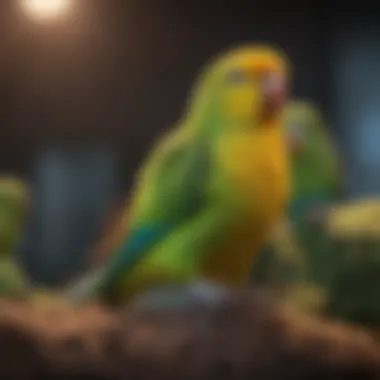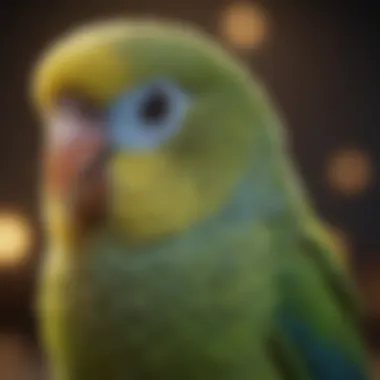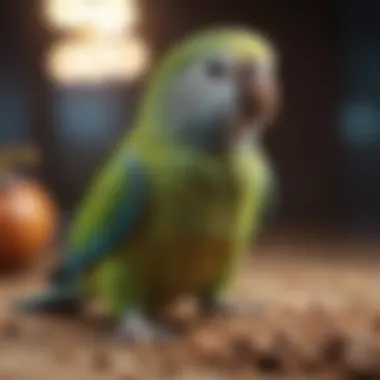Parakeet Beginner's Guide: Essential Insights for New Owners


Intro
Parakeets are fascinating creatures with vibrant personalities. For anyone considering one as a pet, it is essential to understand their needs, behaviors, and the kind of care they require. This guide aims to equip new parakeet owners with the necessary insights to create an enriching environment, promoting health and happiness for their feathered friends. With proper knowledge, you can enjoy a fulfilling companionship with your parakeet, ensuring both you and your pet thrive together.
Understanding Your Pet
Understanding parakeets begins with recognizing their unique traits and needs. These charming birds have specific behavioral patterns and preferences that influence how they interact with their environment and owners.
Pet Behavior Basics
Parakeets are social and intelligent birds. Often, they thrive on interaction with humans and other birds. They communicate through a range of chirps and whistles. Recognizing these sounds can help you understand their moods and needs better. Observe their body language; for example, a relaxed parakeet may stand tall and preen its feathers, whereas an agitated bird may puff up or be quiet.
Common Breed Characteristics
Different parakeet species can exhibit various behaviors and characteristics. For instance, the budgerigar, or budgie, is one of the most popular species. They are playful and enjoy social environments. Other breeds, like the Indian ringneck, are known for their intelligence and ability to mimic human speech. Each breed may require different social interactions, so it is crucial to familiarize yourself with the specific traits of your chosen species.
Species-Specific Needs
Each parakeet species has distinct needs that must be met for robust health and well-being. For example, the diet for a budgie differs from that of an Alexander parakeet. Additionally, space requirements may vary; larger species need bigger cages and more room to move. Understanding these nuances will ensure that you provide proper care tailored to your parakeet's requirements.
Pet Care and Maintenance
Caring for parakeets requires a commitment to their daily needs, including nutrition, grooming, and hygiene.
Feeding Guidelines
A balanced diet is vital for a parakeet’s health. Seed mixes are common, but they should not compose their entire diet. Fresh fruits and vegetables should be included to offer essential vitamins and minerals. Healthy options include spinach, carrots, and apples. Ensure minerals and calcium are also available through cuttlebones or mineral blocks.
Grooming Essentials
Regular grooming keeps your parakeet comfortable and healthy. Nail trimming should be done periodically to prevent overgrowth. Moreover, a shallow dish of water allows them to bathe, keeping their feathers clean and promoting their well-being.
Hygiene Practices
Maintaining a clean environment is key. Regularly clean the cage and replace food and water to prevent bacterial growth. A proper hygiene routine enhances your pet's health and minimizes the risk of any diseases.
Training and Development
Training your parakeet can enhance its life experience considerably. It fosters a bond and encourages positive behaviors.
Basic Commands and Skills
Start with simple commands. Using a light tone, teach your parakeet to come to you, step up, or perform tricks. Consistency is vital; repetition reinforces their learning.
Behavioral Training Techniques
Positive reinforcement works best. Reward your parakeet with treats or praises when they follow commands or exhibit good behavior. This method encourages them to repeat these actions in the future.
Addressing Common Behavior Issues
If behavioral issues arise, identifying triggers is essential. For instance, if your bird screeches excessively, determine if it’s bored, scared, or seeking attention. By understanding these patterns, you can address them effectively through additional social interaction or environment enrichment.
Health and Wellness
Regular health checks are crucial for your parakeet's longevity.
Routine Vet Check-ups
Annual vet visits help monitor your parakeet's health. A professional can identify any potential problems early. Discuss any changes in behavior or appearance with your vet during these visits.
Vaccination Needs
Vaccinations help protect your birds from common diseases. Ensure your vet provides the necessary vaccinations appropriate for your parakeet species.
Recognizing Signs of Illness


Be vigilant for any changes in behavior. Signs like fluffed feathers, lack of appetite, or unusual droppings can indicate health issues. Consult a vet promptly if you notice any abnormalities.
Enrichment and Activities
Engaging your parakeet in enriching activities is essential for their mental and emotional well-being.
Indoor vs.
Outdoor Activities
While indoor playtime is often safer, some parakeets enjoy supervised outdoor time. Ensure the area is secure, and keep them away from potential predators. Indoors, set up play gyms or perches for climbing.
Interactive Toys and Games
Provide toys that stimulate your parakeet’s mind. Rotating toys will keep them interested; try puzzles, bells, or foraging toys. These activities help prevent boredom and encourage physical activity.
Socialization Opportunities
Regular social interactions are beneficial. Hang out with your parakeet, talk to them, or allow them to interact with other birds safely. This interaction mitigates loneliness and builds trust between you and your pet.
Embracing the role of a parakeet owner involves more than just feeding and housing. Understanding their behavior, caring for their health, and offering mental stimulation are all vital components that contribute to a thriving pet experience.
Prelims to Parakeets
Parakeets, often cherished for their vibrant colors and playful nature, have become popular pets in numerous households. Understanding the fundamentals of parakeet care is the foundation for a fulfilling companionship. New owners must not only appreciate their beauty but also recognize their complexities.
Becoming familiar with parakeets involves more than just admiration. Owners should engage with the specific needs and behaviors of these birds. This section will elaborate on the significance of comprehending parakeet species, their social dynamics, and the impact of a well-prepared environment. Addressing these elements ensures that both the owner and the parakeet thrive.
Understanding the Parakeet Species
Parakeets belong to the family Psittacidae, which encompasses a wide range of species. The most commonly kept variety is the budgerigar, or budgie. Originally from Australia, budgies are small, social birds that often form strong bonds with their owners.
Different species of parakeets are available, each offering unique traits. Some are known for their vocal mimicry skills, while others display vivid plumage.
Key Characteristics of Parakeet Species:
- Size: Budgerigars are smaller in size, approximately 7 inches, while larger species, like the Indian Ringneck, can reach up to 16 inches.
- Color: Parakeets exhibit a wide array of colors from greens and yellows to blues and whites.
- Lifespan: Generally, parakeets live between 5 to 15 years, depending on their species and care.
Understanding these characteristics aids in making informed decisions suitable for your lifestyle. Knowledge of the species contributes to better habitats, catering to their social and nutritional needs.
Choosing the Right Parakeet
Choosing the right parakeet is a crucial first step in your journey as a pet owner. This decision not only impacts the well-being of the bird but also shapes your experience as a caretaker. Parakeets come in various species, each with unique needs and temperaments. Understanding these differences plays a significant role in selecting a bird that fits your lifestyle, expectations, and capacity for care.
When deciding on a parakeet, consider factors such as personality traits, size, and lifespan. Different species may have varying levels of sociability and vocalization. For example, the Budgerigar is known for being friendly and social, making it popular among beginners. Conversely, some lesser-known species may not be as interactive or require more specialized care. By carefully assessing these factors, you can ensure a good match that will enhance both your life and the bird's.
Considerations for First-Time Owners
For first-time parakeet owners, there are key considerations that can guide your choice.
- Time Commitment: Parakeets require daily interaction and care. Consider how much time you can dedicate to bonding and socializing with your bird.
- Living Environment: Your home environment should accommodate the needs of a parakeet. A quieter household is often better suited for an easily frightened species.
- Long-Term Care: Parakeets can live up to 15 years or more. Acknowledge the long-term commitment involved in their care before making a decision.
- Family Dynamics: If you have children or other pets, assess how a parakeet will fit into the family. Their behavior and interaction with other family members will matter significantly.
By taking these aspects into account, new owners can prevent future issues related to compatibility and care.
Selecting a Healthy Bird
Selecting a healthy parakeet is vital for nurturing a happy and vibrant companion. When you visit a pet store or breeder, look for signs of good health. Examine the bird's plumage for shine and smoothness. Dull or patchy feathers may indicate health problems.
Preparing Your Home
Creating a suitable living environment for your new parakeet is crucial. The right home setup impacts the bird's health, comfort, and happiness. A well-prepared habitat supports your parakeet's natural behaviors and enhances their overall quality of life.
Choosing the Right Cage
The cage is the cornerstone of your parakeet's habitat. It should be spacious enough to allow for movement. A larger cage fosters exercise and reduces stress. Look for cages that are at least 18 inches long, 18 inches wide, and 24 inches tall for a single parakeet. The spacing of the bars should be no more than ½ inch apart to prevent escapes or injuries.


When selecting a cage, consider materials such as stainless steel or powder-coated metal, as these are safer and longer-lasting. Avoid cages with lead paint or those made of easily chewed materials. It's also beneficial to choose a cage with horizontal bars, enabling climbing, which is a natural behavior for birds.
Essential Accessories for Comfort
Accessories play a vital role in creating a comfortable environment. Start with bedding material such as paper-based or aspen shavings, which are safe and absorbent for droppings. Providing a diverse range of perches is also important. Include various shapes and sizes, such as natural wood branches, which encourage foot exercise and prevent boredom.
Food and water containers should be easy to clean and refill. Use shallow dishes to prevent drowning incidents. For entertainment, offer toys like swings, chewable items, and foraging puzzles. Rotating toys periodically can keep your parakeet engaged and stimulated.
Safe Environment Considerations
It is essential to consider safety factors when preparing your home for a parakeet. Ensure the area is free from hazards such as toxic plants, curtains, or small objects that could be ingested. Additionally, avoid placing the cage in direct sunlight or near drafts to maintain a stable temperature.
Be mindful of other pets in the household. Ensure they cannot access the cage, as this could cause stress or injury. Regularly check the environment for any risks, such as electrical cords or accessible windows.
Regularly assess your parakeet's living area to keep it secure and comfortable.
Understanding how to prepare your home properly is essential for the well-being of your parakeet. A suitable environment allows for better social interactions and contributes significantly to their happiness.
Understanding Parakeet Behavior
Understanding parakeet behavior is essential for anyone looking to provide a happy and healthy environment for their feathered companion. Parakeets are social creatures with complex behaviors influencing their emotional and physical well-being. Recognizing these behaviors can help owners create a nurturing atmosphere that fosters bonding, reduces stress, and promotes overall health. Therefore, grasping the nuances of parakeet interaction is vital for responsible ownership.
Social Interactions and Bonding
Parakeets are inherently social animals. Their natural instincts lead them to seek companionship and build bonds, whether with other birds or humans. Social interactions play a crucial role in a parakeet's health. Engaging with your bird on a daily basis can prevent loneliness, contributing to better mental wellness.
To cultivate a strong bond, consider the following:
- Time investment: Spend time talking and playing with your parakeet. This interaction boosts trust and comfort.
- Routine handling: Regularly handle your bird, ensuring it feels secure and valued. This can involve gentle petting or simply letting it sit on your shoulder.
- Observing body language: Be attentive to your parakeet's body language. Signs like tail waving or soft chirping indicate happiness, while fluffed feathers may indicate discomfort. Understanding these cues enhances interaction.
Bonding is a gradual process that varies for each parakeet. Patience is key. Over time, you will likely witness your parakeet responding positively to your presence, reinforcing the connection between you.
Common Behavioral Traits
Familiarizing yourself with common behavioral traits can offer insight into how to care for your parakeet effectively. Here are some traits that often surface among parakeets:
- Vocalization: Parakeets are known for their chatter. They communicate through various sounds, from whistles to chirps. This vocalization can indicate boredom, excitement, or distress, making it essential to pay attention.
- Playfulness: These birds enjoy playtime. Providing toys and engaging them in activities can keep your parakeet stimulated and happy.
- Grooming: Parakeets spend a considerable amount of time grooming themselves. This behavior keeps their feathers clean and helps them regulate body temperature. If you observe your bird meticulously grooming, it's a sign it feels safe and healthy.
- Exploration: Parakeets are naturally curious and will often explore their surroundings. Safe exploration is helpful in promoting exercise and mental stimulation. Thus, ensure their environment is enriched with various places to perch and explore.
Incorporating these elements into your daily routine can improve your understanding of your parakeet. Observing and adapting to its behavior can lead to a happier pet and a more fulfilling experience for both owners and birds.
Important: Understanding parakeet behavior is not just about companionship; it's about enhancing the quality of life for your feathered friend.
Nutritional Needs of Parakeets
Understanding the nutritional needs of parakeets is crucial for any new owner. It goes beyond simply filling a food dish. A balanced diet impacts their overall health, energy levels, and even mood. Poor nutrition can lead to various health problems, making it essential to understand what constitutes a well-rounded diet for these birds.
Understanding a Balanced Diet
A balanced diet for parakeets includes a variety of foods that provide the vitamins, minerals, and proteins they need. Seeds alone cannot meet all the dietary requirements. Ideally, their diet should include:
- Pellets: These are designed to provide essential nutrients and should constitute a major part of their diet.
- Fresh Fruits and Vegetables: Foods like apples, carrots, and spinach are excellent choices for vitamins and hydration.
- Grains and Nuts: Small amounts of millet, oats, and unsalted nuts can be included occasionally.
- Fresh Water: Clean drinking water must always be available. Change it daily to ensure it stays fresh.
By offering a mix of these options, parakeets can enjoy a well-rounded and nutritious diet.
Common Food Options and Supplements
When it comes to choosing food for parakeets, quality matters. Here are some common options to consider:
- Pelleted Diets: Brands like Harrison's Bird Foods or Kaytee Exact offer specialized pellets designed for parakeets. These often contain a blend of seeds, fruits, and vegetables, ensuring all bases are covered.
- Fresh Produce: Regularly offer foods like bell peppers, broccoli, and peas. Avoid avocado, as it is toxic to birds.
- Seeds: While seeds can be a part of their diet, they should not be the primary food. Opt for high-quality seed mixes, such as Lafeber or Zupreem.
- Supplements: Calcium and vitamin supplements can be beneficial, especially for laying females. Brands like Zoo Med offer good options.
Always introduce new foods gradually to avoid digestive issues. Monitor how your parakeet reacts to each new addition.
Overall, understanding and meeting the nutritional needs of parakeets will lead to healthier, happier birds. As a new owner, investing time in learning about their diet is vital for fostering their well-being.
Health and Wellness


Health and wellness are critical components of parakeet ownership. Recognizing the signs of illness and understanding routine veterinary care can significantly impact the quality of your bird's life. Parakeets are somewhat vulnerable to various health issues, some of which may arise due to environmental factors, dietary inadequacies, or even stress. Thus, being vigilant about their health can ensure they thrive in your care.
Recognizing Signs of Illness
Understanding how to recognize signs of illness in parakeets is essential. Birds are often very good at hiding their illnesses. Therefore, as a new owner, you need to observe their behavior closely. Common indicators of health problems include:
- Changes in appetite: A sudden loss of interest in food can signal an issue.
- Abnormal droppings: Healthy droppings have a specific appearance. Changes can indicate illness.
- Fluffed feathers: This may indicate that the bird is trying to conserve body heat due to illness.
- lethargy: An active bird becoming suddenly lethargic often points to health concerns.
- Vocal changes: A parakeet that usually chirps may stop vocalizing when unwell.
- Eye discharge or swollen eyes: These can be signs of respiratory or other illnesses.
If you notice any of these signs, it is important to consult with an avian veterinarian promptly. Early diagnosis can make a difference in treatment effectiveness.
Routine Veterinary Care
Just like any pet, parakeets require routine veterinary care. Establishing a relationship with an avian veterinarian is crucial for ensuring long-term health. Regular check-ups can help prevent illness and catch potential issues before they become more serious. During these visits, the vet can conduct several evaluations, which may include:
- Physical examination: A complete physical check-up to assess overall health.
- Nutritional assessment: An analysis of diet to ensure balanced nutrition is being achieved.
- Beak and feather checks: These are essential as abnormalities can signify health problems.
Training Your Parakeet
Training your parakeet is a critical aspect of responsible pet ownership. It enhances the bond between you and your bird, promotes mental stimulation, and encourages good behavior. Every parakeet has the potential to learn various commands and tricks, which can significantly enrich their lives. Furthermore, training sessions provide opportunities for social interaction, reinforcing trust and understanding between the pet and the owner.
Basic Commands and Tricks
Teaching basic commands to your parakeet is the foundation of effective training. Start with simple commands like "step up" or "come here". These commands help you communicate with your bird, making it easier to handle them in different situations. As you progress, you can introduce more complex tricks, such as spinning or playing peek-a-boo. Here are some tips for training:
- Short Sessions: Keep training sessions brief, around 5 to 10 minutes, to maintain your bird’s attention.
- Consistency: Use the same words and gestures every time.
- Patience: Some birds might take longer to learn than others.
By ensuring consistency, your parakeet will better understand what you want them to do. Celebrate small wins to encourage them to try new things.
Positive Reinforcement Techniques
Positive reinforcement is an effective training methodology that encourages good behavior through rewards. This technique hinges on the idea that birds learn better when they associate actions with positive outcomes. Use treats, praise, or affection to reward your parakeet when they successfully follow a command. It is vital to be aware of the following:
- Timing: Reward your bird immediately after they perform the desired action to reinforce the behavior.
- Choose Appropriate Rewards: Use their favorite treats to motivate them. Seeds, sliced fruits, or small pieces of veggies work well.
- Avoid Negative Reinforcement: Focus on positive outcomes, not punishment. This helps build a trusting relationship.
Positive reinforcement fosters a sense of security and encourages your bird to learn and explore.
Creating an Enriching Environment
Creating a stimulating environment for your parakeet is crucial for its well-being. Parakeets are intelligent and social birds that thrive on interaction and activity. An enriching setting not only keeps them happy but also promotes their mental and physical health. When designing their living space, consider elements that engage their natural instincts and allow them to express themselves.
Toys and Social Interaction
Toys are more than just playthings for parakeets; they are essential for mental stimulation and physical exercise. Selecting appropriate toys can keep your bird engaged and reduce the risk of behavioral issues caused by boredom. Look for toys that offer different textures, sounds, and movements. Rope swings, wooden blocks, and foraging toys can provide variety and keep your parakeet entertained.
Social interaction is also important. Consider spending time with your parakeet daily. Talking, singing, or playing together can enhance the bond between you and your bird. Parakeets are social creatures and often thrive when they have companionship. If you can, think about getting a second parakeet to keep each other company. This can reduce loneliness and promote social behaviors.
Ensuring Mental Stimulation
Mental stimulation is essential for your parakeet’s well-being. Boredom can lead to issues such as feather plucking or aggression. To prevent this, incorporate activities that challenge their minds, such as puzzle toys or games that require them to think and problem-solve. Foraging is a natural behavior for birds, so make an effort to hide their food in toys or around the cage. This will encourage them to engage in natural foraging behaviors.
Establishing a routine that includes interactive periods can be beneficial. For example, set aside time each day where you allow your parakeet to explore a safe area outside the cage. This exploration time can encourage them to use their natural instincts to observe and discover. Keeping your parakeet mentally stimulated is key to ensuring a long, healthy life.
Final Thoughts on Parakeet Care
Caring for a parakeet is not just about feeding and cleaning its cage. It is about forming a relationship that will last many years. This section is an essential culmination of the guidance provided in this article. It emphasizes the commitment required and the resources available for new parakeet owners.
The Lifelong Commitment
Owning a parakeet is a lifelong commitment. These birds can live for over a decade with proper care. This means that owners must be prepared for many years of responsibility. Beyond just basic needs, one must provide an environment where the bird can thrive emotionally and socially. Parakeets are social creatures, requiring interaction and bonding time with their human companions. Ensuring that they have a stimulating environment will lead to a happier and healthier bird. Remember that adopting a pet is akin to taking on family responsibilities. This includes not only their day-to-day necessities but also planning for their future needs.
Consider the following aspects when thinking about this lifelong commitment:
- Emotional Attachment: Relationships with pets can grow deep. Birds often recognize their owners and respond to them.
- Financial Planning: Regular expenditures on food, accessories, and vet visits are part of the responsibility.
- Time Investment: Daily interaction and care are essential for their well-being.
Ultimately, this commitment is about providing the best care possible, leading to fulfillment for both the parakeet and the owner.
Resources for Ongoing Education
Education about parakeet care does not stop at ownership. Continuous learning helps ensure that owners provide the best possible environment and care for their birds. Resources are available in many forms—some being more accessible than others. Here are some valuable tools:
- Books on Avian Care: Numerous comprehensive guides explain specific care techniques, behavioral understanding, and dietary needs.
- Online Forums: Websites like Reddit have communities of parakeet enthusiasts who share experiences, tips, and advice.
- Veterinary Guidance: Regular check-ups with an avian vet contribute to ongoing health. Vets can also offer educational sessions on advanced care.
- Social Media Groups: Platforms such as Facebook can connect owners with parakeet care groups.







